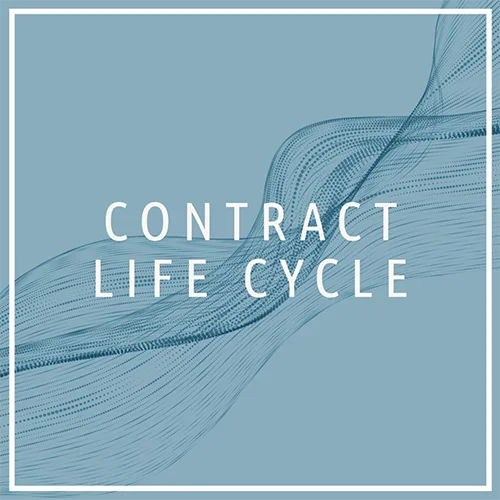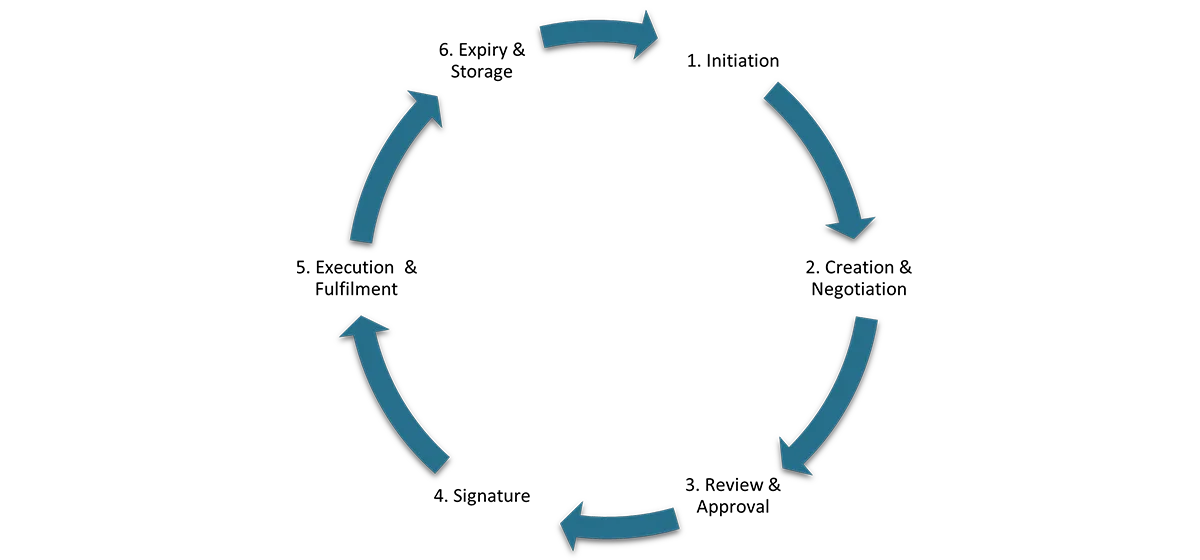I. What is the contract life cycle?
The word contract life cycle describes the different stages that a contract goes through within its “life span” in a company. The contract life cycle basically consists of six different stages that start with the initiation of the contract and run through its implementation to its archiving.
Typically, contracts follow the same pattern during their life cycle. This opens the possibility for companies to reap enormous benefits through effective management of contracts, along the contract stages. For example, errors can be avoided, revenue can be generated, and resources can be saved and released elsewhere. This increases effectiveness and in turn leads to higher productivity.
Usually, some stages of the contract life cycle are given more time and importance than others. To better understand why this is the case, we will look at each stage and its importance in more detail below.
II. Through which stages does a contract pass?
A contract essentially goes through six successive stages in the company. The exact names as well as the number of stages can vary slightly, depending on the source. That’s why there is no clear, universally applicable definition. However, based on our own experience as a contract management software vendor, we have defined the following six stages: Initiation, Creation and Negotiation, Review and Approval, Signature, Execution and Fulfilment, as well as Expiry and Storage.
1. Initiation
The contract life cycle begins with the initiation of the contract. What is meant by this is the conception, i.e. the first idea for a contract. Here, the purpose and content of the contract and the contractual partners are essentially defined. These are basic conditions that must be established before the contract is drawn up.
Furthermore, it is important to clarify the goals and tasks of all parties involved. Every contract between two business partners, be it end customers, suppliers or customers in the B2B segment, is meant to legally secure and strengthen the business relationship. The mutual interests must be taken into account and brought together in the contract. Once the goals, tasks and interests have been defined, the drafting of the contract can begin.
When drawing up a contract, it is important to bear in mind that a contract is a legally binding document. Therefore, one should be well organised and prepared in a structured way from the very beginning. For example, what happens if the business partner files for bankruptcy during the term of the contract? What does the contract provide for if the business partner goes out of business? Is the business financially secure? These questions must definitely be clarified before the contract is concluded.
2. Creation and Negotiation
After conceptualisation, the second stage is about creating a first draft contract. In this process, existing templates are often used for the creation of new contracts in companies. That means, for example, that contracts with other business partners are copied and filled with the new data. This saves time and ensures that the most important clauses are already included for the same types of contracts. In modern, professionally set-up companies that operate their contract management with the help of software, so-called contract management software, there is often a separate template and clause management system.
Once the first draft of the contract is ready, the negotiations between the contracting parties continue. Here, the first draft is adapted and versioned as often as necessary until both parties see their interests safeguarded. The easiest way to do this is in contract management software, where both parties can view and edit the draft contract.
In this contract stage, it is decided whether a business relationship will be established or not. Various aspects such as the costs or the price, the tasks, responsibilities, and much more must be clarified and defined here. Therefore, this second stage of the contract life cycle is particularly important.
3. Review & Approval
Once the contract has been negotiated to the satisfaction of both parties, the draft contract is passed on for internal review and approval. This is usually followed by a legal review by the legal department. It may happen that the contract has to be adjusted again until it meets all legal requirements. Only then is it approved by the superiors.
Software can support the process of review and approval with the help of workflows. The responsible persons within the workflow are contacted directly and assigned one or more tasks, for example the final approval. The advantage of automatic workflows is that they can speed up contract creation enormously. In addition, all employees can view, edit and comment on the contract in real time before the contract enters the next stage.
4. Signature
The fourth stage in the contract life cycle should be the simplest and the quickest, although legally it is the most important step of all contract stages: The signing of the previously negotiated contract. One advantage of our digitalised world is that nowadays this is also possible by means of digital, legally binding signatures. This means that documents no longer must be sent by post and signed, but that this process is completely digital. Only in the case of certain contracts, such as real estate purchase contracts, which require a personal appearance and a notary, must digital signatures currently still be dispensed with.
5. Execution and Fulfilment
The fifth contract life cycle stage is about the execution and fulfilment of the obligations and tasks set out in the contract. This includes, among other things, the delivery or receipt of goods and services or payment arrangements. Regular audits help to ensure that one does not lose track and that all parties fulfil their obligations. The use of contract management software can also help, for example by setting up automatic notifications and deadline monitoring. If ERP or CRM systems are also linked to the software, further relevant information can be processed and taken into account.
The fifth stage in the contract life cycle is one of the longest in relation to the others, as it covers the entire service provision, i.e. the entire contract period. It can range from a few days and weeks to several months and even years.
At the end of this stage, it becomes clear whether the life cycle of the contract begins anew or whether it ends for the time being, i.e. whether the contract expires, is extended or terminated. In the case of an extension, adjustments may then be made to the contents of the contract that have already been established. A frequently asked question is, for example, the question of a price reduction. If the contract starts again with a contract extension, the cycle starts again from stage one or two. If the contract expires or is terminated, it moves on to the next stage: expiry and storage.
6. Expiry and Storage
The sixth and final stage of the contract life cycle is about contract expiry and contract archiving. The end of the term of a contract is not the same as the end of the contract life cycle. On the contrary, the contract probably enters its longest phase only now, when it is transferred to the archive or the electronic archiving system. Old contracts are often still used internally, either as a template for new contracts or simply because old contract data is needed.
In addition, legal requirements, depending on the country, apply to certain documents. In Germany it is the so-called retention periods. Due to the legal retention periods, it is forbidden to delete contracts and their data or documents before the expiry of fixed periods. In most cases, archiving periods of six to ten years apply to contract data. This is the minimum period for which documents must be kept. In addition, there is, among other things, GoBD-compliant, audit-proof archiving, which is also prescribed by law and must be followed.
Note: GoB, GoBD and audit security – a book with seven seals? We have summarised the most important key points for you in our article “Archiving”.
III. Contract Lifecycle Management (CLM) in the digital age
As can be seen, the contract life cycle is quite an extensive and complex process. Since almost all departments of the company come into contact with it, the management of the contract life cycle is particularly relevant. For this reason, there are now permanent teams in companies that only deal with this “contract lifecycle management” (CLM).
Contract lifecycle management can generally be done in different ways and by different means. Nowadays, more and more companies rely on digital contract management and thus also on an electronic contract management system. Among other things, this has the advantage that analogue paper files no longer have to be used, but instead all documents, contracts and data are available at any time, from anywhere.
One way to operate digital contract lifecycle management in the company is Microsoft 365, which already provides a well-equipped toolbox in the standard version that allows complex specialised applications to be built. However, since it takes some expertise and, above all, resources to build highly functional (business) applications on one’s own from the given basic equipment, it is advisable to involve a specialised Microsoft partner, like Portal Systems, in such a project.
Hamburg, November 28, 2022
Author: Sara Glöckner
Category: Business Wiki
You like what you read? Please feel free to share this article:







